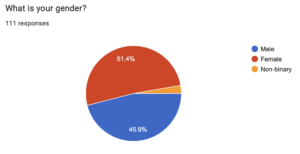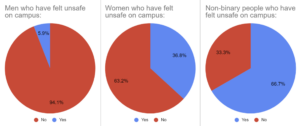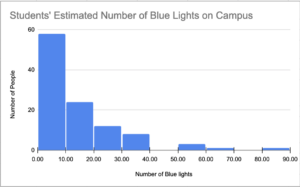Many students do not feel safe at night on their college campuses, particularly when they are traveling by themselves. A 2021 survey of college students published by ADT and the Cleary Center found that more than 82% of students felt concerned about their personal safety on their college campuses, with 74% reporting that they feel unsafe walking home in the dark, and 65% reporting that they feel unsafe leaving a bar or party alone [1].
A common safety system on college campuses is blue-light emergency phones, which are a system of emergency phones that can call local authorities and report location data that are placed around campus with blue lights on top of the phones for visibility purposes. A Department of Justice special report found that 92% of 4-year college campuses have blue-light emergency phones [2].
Blue-light emergency phones began to be installed in the early 1980s, “many colleges and universities saw a rise in student interest and activism around ‘safety’ via three avenues: ‘lighting tours’ designed to identify and remedy insufficient lighting on and around campus; concerns about transportation, and the emergence of walking or driving escort services; and antirape and feminist activism” [3]. They continued to become more prevalent through the 1990s, as campus safety gained more attention after the 1986 murder of Jeanne Clery in her dormitory at Lehigh University and the subsequent passage of the Clery Act in 1990.
However, today in the era of cell phones, there is a question of whether blue-light emergency phones are actually utilized and have a significant impact on campus safety. In 2016, the Indiana Daily Student reported that only four blue-light calls in the last 20 years were for legitimate emergencies at Indiana University [4]. Multiple schools have chosen to either remove or downsize their blue light systems, sometimes replacing them with safety apps that can be downloaded on students’ smartphones, although this has been a controversial choice at some campuses.
Others argue that blue-light systems are still relevant, pointing out that smartphones can run out of battery or lose cellular service. Additionally, an article published in the International Journal of Cultural Studies posits that blue-light emergency phones, regardless of their ability to create safety, constitute an “infrastructure of feeling,” increasing student and parent comfort [3].
Clearly, although there is definitely an issue of student safety on college campuses, there are mixed opinions on the current safety measures in place to address this issue. Campus safety became an increased concern to many at Lafayette College last year in 2021, after two break-ins and attempted assaults at off-campus student residences [5]. Both incidents resulted in a campus-wide lockdown, with a “purge-like” alarm alerting students to stay inside. Our team chose to investigate current opinions on campus safety and the blue-light system that exists at Lafayette College through a survey of 111 students. We received 111 responses, with a fairly even gender distribution.

About 23% of students reported that they had felt unsafe on campus, although the responses greatly differed in different gender segments.

Most students did know what the blue-light system was, and the location of at least one blue-light emergency phone.

However, as a whole students were vastly uninformed about blue-light emergency phones’ location and the number present on campus. According to an interview we conducted with the director of Public Safety at Lafayette College, there are currently 72 blue-light emergency phones on campus. But students struggled to name the location of more than a few blue-lights, and the majority of students believed there were only 0-10 blue-light emergency phones on campus.

We seek to address the issue of safety at Lafayette College and other college campuses and the current underutilization of current safety systems in place. As the above information shows, there is a significant gap between cases where an emergency response system would be useful and the number of times that the system is actually used. We believe that the blue light system can be augmented to help the system be available in these emergency situations and add redundancy to increase the feeling of safety on college campuses.
References